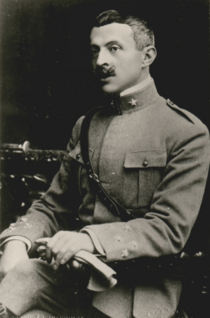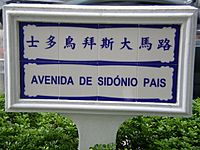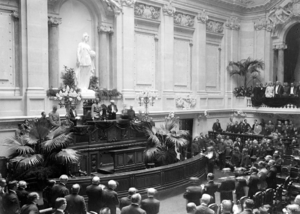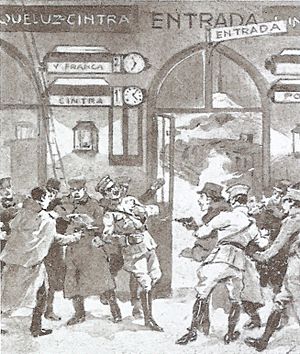Sidónio Pais facts for kids
Quick facts for kids
Sidónio Pais
CavC OA CavA
|
|
|---|---|

Pais in uniform, c. 1918
|
|
| President of Portugal | |
| In office 9 May 1918 – 14 December 1918 |
|
| Prime Minister | Himself (de facto) |
| Preceded by | Bernardino Machado |
| Succeeded by | João do Canto e Castro |
| Prime Minister of Portugal | |
| In office 12 December 1917 – 9 May 1918 |
|
| President | Cabinet (ex officio) Himself (acting) |
| Preceded by | Revolutionary Junta |
| Succeeded by | João Tamagnini Barbosa |
| President of the Revolutionary Junta | |
| In office 8 December 1917 – 12 December 1917 |
|
| President | Bernardino Machado |
| Preceded by | Afonso Costa (Prime Minister) |
| Succeeded by | Himself (Prime Minister) |
| Minister of Foreign Affairs | |
| In office 11 December 1917 – 9 May 1918 |
|
| Prime Minister | Himself |
| Preceded by | Revolutionary Junta |
| Succeeded by | Francisco Xavier Esteves |
| Minister of War | |
| In office 11 December 1917 – 9 May 1918 |
|
| Prime Minister | Himself |
| Preceded by | Revolutionary Junta |
| Succeeded by | João Tamagnini Barbosa |
| Ambassador of Portugal to Germany | |
| In office 17 September 1912 – 10 March 1916 |
|
| Nominated by | Manuel de Arriaga |
| Preceded by | Viscount of Pindela |
| Succeeded by | José Maria Lambertini Pinto |
| Minister of Finance | |
| In office 12 November 1911 – 16 June 1912 |
|
| Prime Minister | Augusto de Vasconcelos |
| Preceded by | Duarte Leite |
| Succeeded by | António Vicente Ferreira |
| Minister of Commerce and Public Works | |
| In office 4 September 1911 – 12 November 1911 |
|
| Prime Minister | João Chagas |
| Preceded by | Manuel de Brito Camacho |
| Succeeded by | Estêvão de Vasconcelos |
| Member of the Chamber of Deputies | |
| In office 15 June 1911 – 26 November 1912 |
|
| Constituency | Aveiro |
| Personal details | |
| Born |
Sidónio Bernardino Cardoso da Silva Pais
1 May 1872 Caminha, Portugal |
| Died | 14 December 1918 (aged 46) St. Joseph Hospital, Lisbon, Portugal |
| Cause of death | Assassination |
| Resting place | National Pantheon, Lisbon, Portugal |
| Political party | National Republican (Sidonist) |
| Spouse |
Maria dos Prazeres Martins Bessa
(m. 1895) |
| Relations | Bernardo Sassetti (great-grandson) |
| Children | 6 |
| Education | Liceu de Viana do Castelo |
| Alma mater | Military Academy University of Coimbra |
| Signature |  |
| Nickname | President-King |
| Military service | |
| Allegiance | |
| Branch/service | |
| Years of service | 1888–1918 |
| Rank | Major |
Sidónio Bernardino Cardoso da Silva Pais (born May 1, 1872 – died December 14, 1918) was an important Portuguese politician, military officer, and diplomat. He served as the fourth president of the First Portuguese Republic in 1918. He is known as one of the most talked-about figures in Portugal's modern history. The famous writer Fernando Pessoa called him the "President-King," a name that people still use today to describe his time in power.
Contents
Sidónio Pais: Portugal's "President-King"
Early Life and Education
Sidónio Pais was born in Caminha, Portugal, on May 1, 1872. He was the oldest child of Sidónio Alberto Marrocos Pais, who was a notary, and Rita Júlia Cardoso da Silva. Both of his parents were from Caminha.
He went to primary school in Sertã and then secondary school in Viana do Castelo. After that, he studied mathematics and philosophy in Coimbra. In 1888, he decided to join the military and went to the Army School. He was a very good student and quickly moved up in rank. He became a sub-lieutenant in 1892, a lieutenant in 1895, a captain in 1906, and a major in 1916.
After his military training, Pais also studied at the University of Coimbra. He earned a degree in mathematics and later received his doctorate from the same university in 1898.
Journey into Politics
Even when he was a student in Coimbra, during the last years of the Portuguese Monarchy, Sidónio Pais showed his support for a republic. He also briefly joined a masonic lodge in Coimbra.
Because he was a talented mathematician, he stayed in Coimbra and became a professor. He taught advanced mathematics and also worked as a director at the Brotero Industrial School. In 1910, he became the vice-chancellor of the university.
When the First Portuguese Republic was created in 1910, Pais became very active in politics. He was chosen to be a representative in the group that wrote Portugal's new constitution in 1911. He then became the Minister of Public Works in August 1911. After that, he served as the Minister of Finance until June 1912.
As tensions grew before World War I, Pais was appointed as Portugal's ambassador to Berlin, Germany, in August 1912. He stayed in this important role until March 1916. This was a difficult time because Portugal was becoming more supportive of the Allies, while Pais himself was seen as more friendly towards Germany. Germany declared war on Portugal in 1916 after Portugal seized German ships.
Becoming President
When Sidónio Pais returned to Portugal, many people who were against Portugal joining the war looked to him as a leader. People were unhappy because the war was hard on the country. Also, the Portuguese army was not doing well in the war. Pais became the main leader against the government.
From December 5 to 8, 1917, he led a military uprising with about 250 soldiers. After three days of fighting, his group won. On December 8, the government handed power over to Pais's military group.
Instead of following the usual rules for forming a new government, the rebels took control. They removed Bernardino Machado from his position as President of the Republic and made him leave the country. On December 11, 1917, Sidónio Pais became the Prime Minister. He also took on the roles of War Minister and Minister of Foreign Affairs. Later, on December 27, he also became the acting President. All these actions went against the Constitution of 1911, which he had helped create.
Challenges and Changes
Sidónio Pais then issued several new laws without asking the Congress. He also suspended important parts of the Constitution. This made the government very strong, with the President having a lot of power. The President became both the Head of State and the leader of the government. His supporters called this new system a "New Republic." This is why he was called the "President-King."
Pais tried to improve relations with the Roman Catholic Church. On February 23, 1918, he changed a law that had separated the Church and the State. This made many traditional republicans and Freemasons angry. However, it gained him a lot of support from Catholics and people in rural areas, who were most of the Portuguese population at the time. This decision also helped Portugal re-establish diplomatic ties with the Vatican.
In another move that went against the Constitution, Pais decided that the President should be chosen directly by the people through a vote. Using his popularity among Catholics, he was elected President on April 28, 1918, with a huge number of votes. He was officially declared President on May 9, 1918. He did not even consult the Congress.
However, in April 1918, the Portuguese army suffered a terrible defeat in the Battle of the Lys during World War I. The Portuguese government struggled to send more soldiers or even provide supplies. After the war ended, Portugal still had trouble bringing its troops back home. Problems in society grew, leading to constant unrest.
This difficult situation marked the end of Pais's popular support. From the summer of 1918, attempts to overthrow his government became more serious and violent. This led the President to declare a state of emergency on October 13, 1918. He tried to control the situation with strong actions against opposing groups. But his government was clearly in deep trouble.
The political situation did not get better, even after the war ended with the Armistice of 11 November 1918.
His Assassination
Sidónio Pais survived one assassination attempt on December 5, 1918. But nine days later, he was killed.
On the evening of December 14, 1918, the president was going to the Lisboa-Rossio Railway Station. He was with his brother and son. He planned to take a train to Porto. When he entered the station around 11 PM, guards were there to protect him. Security had been increased after the earlier attempt on his life. A band was playing music as he arrived.
Inside the station, a man named José Júlio da Costa was waiting. He had a pistol hidden under his cloak. As the President walked past him on the first floor, Da Costa got past the police guards. He fired two shots. The first shot hit Pais in his right arm. The second shot hit him in the stomach, which was a deadly wound. Pais immediately fell to the ground, and everyone panicked. In the confusion, four innocent people were accidentally killed by the guards. The assassin did not try to escape and was arrested after being badly beaten by the crowd. Pais was still alive and was rushed to St. Joseph Hospital, but he died from his wounds before reaching the hospital, just before midnight.
Tens of thousands of people attended Sidónio Pais's funeral. However, there were many interruptions and violent protests during the event. On December 16, João do Canto e Castro was chosen as his successor by the Congress, not through a new public vote.
What Was His Legacy?
The murder of Sidónio Pais was a very difficult time for the First Republic. Pais was a popular leader who presented himself as the last hope for Portugal. His assassination had a huge and lasting impact on Portuguese politics. After his death, political stability disappeared. This led to a long period of crisis that ended almost eight years later with a new dictatorship in 1926.
Many people tried to understand why Pais was so popular. He was described as having a mix of good social qualities and strong character. He was also good at understanding and reflecting what people wanted. He was known for being open about difficult issues and admitting his mistakes.
The writer Fernando Pessoa admired Pais and called him the "President-King." This name stuck because it perfectly described his powerful government. Especially among conservative Catholic groups, Pais became seen as a hero and a martyr. People started a popular following around him, similar to one for another historical figure. Even today, people place fresh flowers and religious symbols at his tomb. This is mainly because he changed some laws that were against the Church. It's interesting because Pais himself was not a very religious person.

Some historians believe that Pais's strong, autocratic style of government contributed to later dictatorships in Portugal. His government did not bring the order it promised. Instead, it added to the chaos of the First Republic and weakened its legitimacy.
The Estado Novo regime, which ruled Portugal for much of the 20th century, used Pais's legacy to its advantage. For example, when the Portuguese National Pantheon was opened in 1966, Pais's body was moved there.
Family Life
Sidónio Pais married Maria dos Prazeres Martins Bessa in 1895. They had five children: four sons and one daughter. He also had another daughter outside of his marriage. He is the great-grandfather of the famous pianist and composer Bernardo Sassetti.
Museum Plans
In 2002, the local government of Caminha bought the ruined house where Pais was born. They paid 175,000 Euros for it. In 2009, an architect was asked to turn the house into a museum. The plan was for the basement to have a room about Pais's presidency. The ground floor would show his life story. The first floor would be a center for documents. The cost of this project was estimated to be one million Euros. However, there has not been much progress on the museum since the mid-2010s.
Honours and Awards
 Sash and Grand-Cross of the Three Orders, as President of the Republic and Grand-Master of the Portuguese Honorific Orders (1917–1918)
Sash and Grand-Cross of the Three Orders, as President of the Republic and Grand-Master of the Portuguese Honorific Orders (1917–1918) Knight of the Order of Christ, Portugal (January 27, 1919)
Knight of the Order of Christ, Portugal (January 27, 1919) Knight of the Order of Aviz, Portugal (October 5, 1933)
Knight of the Order of Aviz, Portugal (October 5, 1933) Officer of the Order of Aviz, Portugal (December 4, 1943)
Officer of the Order of Aviz, Portugal (December 4, 1943)
Images for kids
See also
 In Spanish: Sidónio Pais para niños
In Spanish: Sidónio Pais para niños




